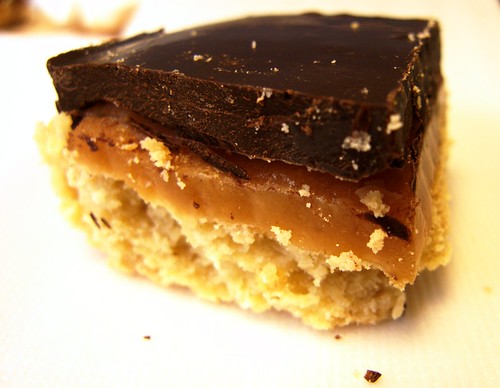
This weekend saw me making millionaire shortbread. Generally speaking, shortbread by itself is lovely, lovely stuff. Adding a layer of caramel to it, and then a layer of chocolate could be seen as gilding the lily slightly. But as a delivery mechanism of high-class carbs and fat there are few things finer. But - and this is a big but - it has to be home-made. Shop-bought millionaire shortbread has a too-thin layer of chocolate and caramel, and the shortbread itself is strange stuff. Come to think about it, even the chocolate and caramel is a bit peculiar, but the shortbread is often more like cheesecake base than proper, crisp, shortbread, and is far too crumbly. The chocolate layer is far too thin and to get it that thin it has to be too warm and probably contains oil and a stabliser of some description. The caramel? Invariably it's dulce de leche, or rather an industrial variant thereof. It tastes of sugar and vegetable fat, with none of the creaminess or texture a good caramel should have.
There's a rant about caramel that I've had for a while; boiling a tin of condensed milk does not make a caramel, it makes dulce de leche, a sticky, thick-ish sauce that tastes of, well, condensed milk. A good caramel is soft and slightly chewy and creamy and has a slight overtone of whatever sugar you used to make it, which is why I make caramel with a mix of sugars (recipe below). And if you're making millionaire shortbread you can't use dulce de leche, because it's too runny. I'll admit, in certain circumstances it's ok stuff (sort of, I'm not really a huge fan), but as a sauce or flavouring, not an structually integral part. Anyway, making a caramel is really very easy, which is why my rant gland starts up whenever I see a jar of dulce on the shelves (at some ridiculous price).
(Technically, a proper caramel is just boiled sugar which has undergone pyrolysis, but for the sake of this post I'm talking about dairy caramels.)
We've established that good millionaire shortbread is homemade, and one more reason is that you can change the thickness of your layers to how you like them, and adjust portion size accordingly. Also, you know what's gone into it and if you like to experiment adjusting the various ingredients to suit your own tastes is simple, and can make some quite exciting treats. Let's look at the basic recipe.
1. Shortbread. This can be as simple or complex as you like. My base recipe (8" square tin) is 150g butter, 75g caster sugar creamed together, and 175g plain flour and 25g semolina beaten into it to form a soft, quite sticky dough. Line your tin with baking parchment so that it covers the base and sides and squish the dough into it with your fingers so that it forms an even layer, then poke the base with a fork a few times and bake at 160C for 25 minutes, ish, until it is golden brown in colour. But, tweak the recipe to suit your tastes; add lemon zest, or lavender, or cardamom to the butter & sugar. Swap some of the flour for cocoa. Add toasted hazelnuts to the mix, or finely chopped stem ginger.
2. Caramel. Once the shortbread has come out of the oven, make your caramel. Don't mess about with this too much - although experiments are good - as the ratios have to be fairly close to stop it recrystallising. I like my caramel to be chewy, but not so much that it'll pull fillings; it does have to have some structural integrity as the chocolate layer needs supporting, so it'll need to hit the soft-to-firm ball stage. In a small heavy-bottomed saucepan put 225g caster sugar, 25g butter and 140ml (a small pot, IIRC) of double cream. Over a low heat, gently stirring constantly, melt everything together, then once the sugar has dissolved turn the heat up and boil until it reaches 120C. If you don't have a sugar thermometer boil for five minutes, take a teaspoon of the caramel and drop into iced water, then try to form the caramel into a ball using your fingers; if it keeps its shape when you take it out of the water it's done, otherwise put the caramel back on the heat for another two minutes (or longer, if the caramel didn't form into a ball underwater) and try again. If it's done, add a good pinch of salt and stir, then pour onto the shortbread; it should spread itself out evenly. To experiment with this layer, you could add similar flavourings to above, but I wouldn't bother. I would, however, tinker with the sugar; use 50/50 white caster and light soft brown, or dark soft brown, or even demarera. You can over or undercook the caramel to make it more or less chewy, but be careful of this. I'll do a post on caramels as sweets in a couple of weeks.
3. Chocolate. Melt some chocolate - about 100g will cover an 8" tin - with a knob of butter and pour it over the caramel. Do what you like here; add chili, more lemon zest, peppermint oil, or melt some contrasting coloured chocolate and swirl it using a cocktail stick, whatever you like. then leave to cool, and refrigerate until completely set. Then take the whole lot out of the tin on the baking parchment and chop into squares, bars, circles, whatever shapes and sizes you like depending on how much of a diabetic coma you like.
Tadah! There's a lot of words up there, but you can summarise them as "make shortbread, make caramel (don't be tempted by dulce de leche), and melt some chocolate". And the results? Oh, so worth it. And it's really difficult to make a bad millionaire shortbread.
